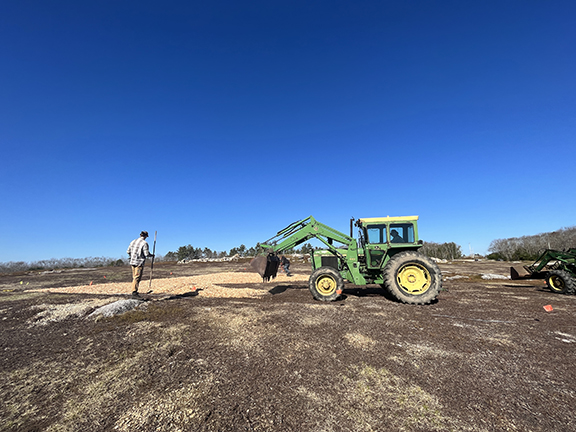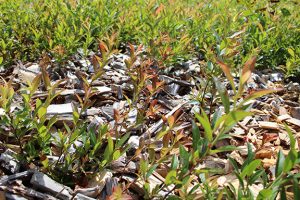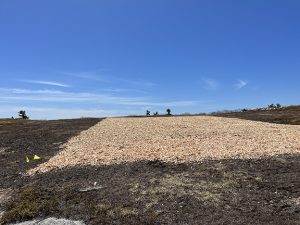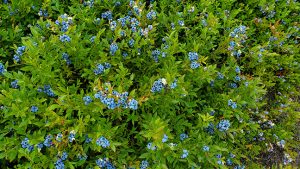Bulletin #2179, Wood Chip Mulching in Wild Blueberry Fields
Bulletin #2179, Wood Chip Mulching in Wild Blueberry Fields (PDF for printing)
By Lily Calderwood, Ph.D., Wild Blueberry Specialist and Assistant Professor of Horticulture, University of Maine Cooperative Extension and Jordan Parks, Wild Blueberry Research Technician, University of Maine Cooperative Extension.
For information about UMaine Extension programs and resources, visit extension.umaine.edu.
Find more of our publications and books at extension.umaine.edu/publications/.
Wood Chip Mulching in Wild Blueberry Fields
Introduction
Most wild blueberry plants are cultivated in the state of Maine, Nova Scotia, and the Québec Province. In these areas, blueberry plants grow in well-drained sandy soils of glacial till and moraines. This soil type has a low water holding capacity which can cause complications to the plants during drought conditions. As climate change progresses, the state of Maine will likely experience both an increase in the severity of drought spells and increased precipitation across the region (Fernandez et al., 2020). This fact sheet will focus on meteorological and agricultural drought. Meteorological drought occurs when there is a decrease or absence in precipitation; an agricultural drought occurs when a crop’s root zone becomes dry during the growing season even though deeper soil layers may be saturated, causing significant crop damage (Heim, 2002). The main factors contributing to drought are increased temperature and wind, low relative humidity, lack of cloud cover, and low precipitation (Condra, 1944).
Seasonal droughts in Maine generally occur in June, July, and August which are critical growing months for wild blueberries in prune and crop cycles. Wild blueberry fields have experienced drought in five (2016 to 2018, 2020, and 2022) of the last eight years. In 2020, growers experienced yield losses from 0.5 to 97.0%, with a state average loss of 44%, due to drought and increased temperatures (Schattman et al., 2021). This is because as the blueberry plants become water-stressed, they also start to lose their ability to take up nutrients without water. This plant requires one inch per week of water allowing it to function properly. Few growers use irrigation with well or pond water sources, and on occasion, water is trucked in to irrigate fields during critical times. One technique that can be used to reduce the effects of drought is to cover entire fields with wood chip mulch.
When whole field mulching, the research to date suggests that a wood chip mulch thickness of 1.0–1.5 inches to be the most successful when soil, pest, and plant parameters are considered.
Benefits of Wood Chip Mulching
Beginning in the 1980s, wood chip mulching has been used in wild blueberry fields to cover bare patches in fields to stimulate rhizome spread, increase water-holding capacity, and provide weed control. The Natural Resources Conservation Service (NRCS) developed a cost-share program to help farmers cover these bare spots with two to four inches of mulch for erosion management based on research conducted at the University of Maine (DeGomez & Smagula, 1990). Given the success of bare-spot mulching, growers became interested in applying mulch to entire fields. Recently, the University of Maine began studying mulch in this context. To date we can conclude that whole-field mulching significantly decreases leaf spot disease, decreases the number of tip midge pupae, increases the level of chlorophyll in leaves, and increases the number of buds per stem in the crop year (Calderwood et al., 2024; Gumbrewicz & Calderwood, 2022). Previously, it was found that having the soil surface covered with mulch smothered small annual weeds but not grasses or broadleaf perennials (Drummond et al., 2009). In 2023, it was found that a 2-inch mulch layer was able to decrease all weed species when compared to the control of no mulch (Calderwood et al., 2024). If you are using mulch for weed control a thicker layer of mulch is suggested. However, also in 2023, we found an increase in mummy berry disease in the area mulched with two inches. The number of stems per unit area (stand density) was not affected by mulch thickness in 2022 and 2023 with treatments of 0.0, 0.5, 1.0, 1.5, and 2.0-inch wood chips (Calderwood et al., 2024). To summarize the whole field mulching research to date, wood chip mulch at thicknesses of 1–1.5 inches is the most successful when soil, pest, and plant parameters are considered.
Mulch Cost
The NRCS has a cost-share program that will pay for most if not all mulch material, equipment, and labor costs associated with the application. Mulch prices from 2022 carried over to 2023, and the price of mulch was $333 per 1000 sqft which is approximately $14,500 per acre at 2.0-inch depth. The itemized cost is shown in Table 1.
| Mulch Depth (inches) | Cubic Yards/Acre | Woodchip Payment/acre ($) | Remaining Funds for Material Application/acre ($) | Total 2022 NRCS Payment/acre ($) |
|---|---|---|---|---|
| 0.50 | 67.50 | 1,687.50 | 1,937.25 | 3,624.75 |
| 1.00 | 135.00 | 3,375.00 | 3,874.50 | 7,249.50 |
| 1.50 | 202.50 | 5,062.50 | 5,811.75 | 10,874.25 |
| 2.00 | 270.00 | 6,750.00 | 7,749.00 | 14,499.00 |
What Type of Mulch Should be Used?
It is important to choose a wood chip mulch and not a bark mulch. Bark mulch will get caught in harvesters and the operator will be constantly removing the mulch from the rake or reel. Mulch can come in a variety of particle sizes and it is beneficial in sawdust form all the way to chip size (Gumbrewicz & Calderwood, 2022) as long as the depth is a minimum of 1.0 inches (Calderwood et al., 2024).
How Should Mulch be Applied?
The application of mulch should be done during the prune cycle when the blueberry plants have not yet emerged. The most efficient way to apply mulch to whole fields is with a manure spreader (Figure 1). Another way to spread this material is with a tractor operator who fills the bucket with mulch and “feathers” the mulch on the ground while a ground crew rakes the mulch to the desired thickness (Figure 2). These are not the only options for spreading mulch. If you have an idea of how to utilize the equipment you have, by all means, use those techniques.


Calculating the Amount of Mulch Needed
- Calculate the square footage of your field.
- Determine what mulch depth you would like to apply.
- Calculate how many cubic yards of material to purchase. There are mulch depth calculators online.
A useful equation you can use is:
- Area to cover (square feet) x [Depth of Mulch (inches) ÷ 324]
- Use your judgment to either round your answer up or down for the supplier and your needs.
Yields and Harvesting Fields with Mulch
During times of low precipitation, mulch has been found to increase yield by decreasing disease pressure to allow for more rhizome development, thus increasing stem numbers and bud numbers (Gumbrewicz & Calderwood, 2022). During times of high precipitation, as seen in 2023, yields did not change between mulch depths of 0.5, 1.0, 1.5, and 2.0 inches compared to plants with no mulch (Calderwood et al., 2024). Harvesters will have to be careful not to dip rakes into the mulch layer, but this is no different than raking in a field with no mulch layer. Once berries have been harvested, mulch pieces have been found to float and be removed in a float tank, but this has not been consistent over the years. Some growers were able to remove mulch pieces with a laser sorter which removed almost all mulch pieces. Furthermore, the pieces that made it past the laser sorter were easily removed. An individual quick freeze (IQF) processor determined that the amount of mulch that got caught in the fruit was based on how wet the berries were coming into the processor.
Limitations
- The mulch data collected for this fact sheet were from fields that were mowed instead of burned after the crop cycle. We do not yet know the effects of burning with a wood chip mulch. Anecdotally, growers who burn two seasons after mulch application have to be careful that the fire doesn’t continue to burn in areas of thick mulch. Overall, growers who burn have not had problems.
- The literature shows that mulch significantly reduces disease and pests, but in 2023 it was observed that a high number of mummy berry and flea beetle were in the 2.0 inch mulch. The reasons for this are not yet known, but it is recommended to use 1.0 to 1.5-inch mulch. Although, it is still good practice to fill bare spots and recently de-rocked fields with a 2.0 – 4.0 inch mulch layer.
- The literature suggests that mulching perennial crops can steal nutrients from crop plants. We have not yet observed this phenomenon in wild blueberry but will continue to monitor plant nutrients. Today, the benefits of mulching far outweigh this possibility.
References
- Calderwood, L., Annis, S., Fanning, P., Schattman, R., & Zhang, Y.-J. (2024). 2023 Wild Blueberry Research and Extension Report.
- Condra, G. E. (1944). Drought, its effects and measures of control in Nebraska.
- DeGomez, T., & Smagula, J. (1990). Mulching to improve plant cover. University of Maine Cooperative Extension Fact Sheet (228).
- Drummond, F., Smagula, J., Annis, S., & Yarborough, D. (2009). Organic wild blueberry production. Maine Agricultural and Forest Experiment Station, Bulletin #852, 43.
- Fernandez, I. J., Birkel, S., Simonson, J., Lyon, B., Pershing, A., Stancioff, E., & Jacobson, G. L. (2020). Maine’s climate future: 2020 update.
- Gumbrewicz, R., & Calderwood, L. (2022). Comparison of wood mulch particle sizes for wild blueberry management in a changing climate. International journal of fruit science, 22(1), 551-567.
- Heim, R. R. (2002, 01 Aug. 2002). A Review of Twentieth-Century Drought Indices Used in the United States. American Meteorological Society, Bulletin #83(8), 1149-1166.
- Schattman, R., Goossen, C., & Calderwood, L. (2021). The 2020 Maine drought and agriculture report. University of Maine: Orono, ME, USA, 1-30.
Information in this publication is provided purely for educational purposes. No responsibility is assumed for any problems associated with the use of products or services mentioned. No endorsement of products or companies is intended, nor is criticism of unnamed products or companies implied.
© 2024
Call 800.287.0274 (in Maine), or 207.581.3188, for information on publications and program offerings from University of Maine Cooperative Extension, or visit extension.umaine.edu.
In complying with the letter and spirit of applicable laws and pursuing its own goals of diversity, the University of Maine System does not discriminate on the grounds of race, color, religion, sex, sexual orientation, transgender status, gender, gender identity or expression, ethnicity, national origin, citizenship status, familial status, ancestry, age, disability physical or mental, genetic information, or veterans or military status in employment, education, and all other programs and activities. The University provides reasonable accommodations to qualified individuals with disabilities upon request. The following person has been designated to handle inquiries regarding non-discrimination policies: Director of Equal Opportunity, 5713 Chadbourne Hall, Room 412, University of Maine, Orono, ME 04469-5713, 207.581.1226, TTY 711 (Maine Relay System).




